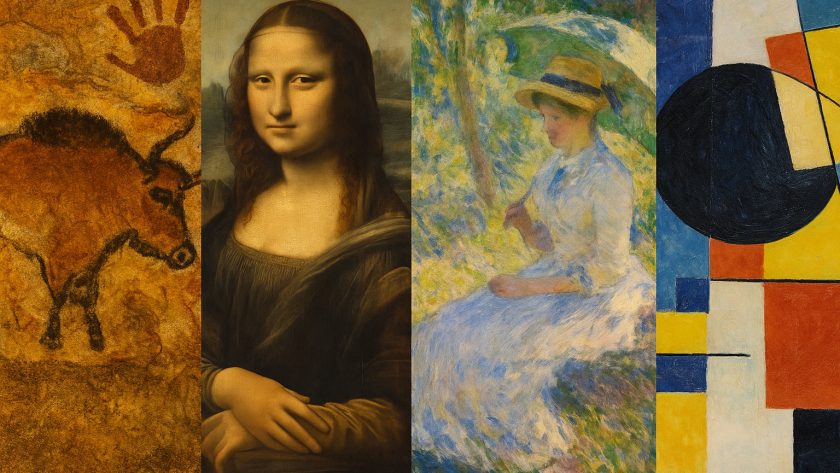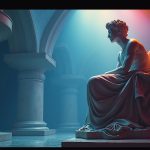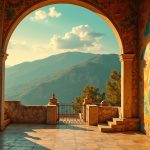Painting didn’t begin in galleries or on museum walls. It started deep in caves, with soot and minerals pressed into stone. What began as primal storytelling has turned into a force that challenges perception, mirrors societies, and pushes visual boundaries. How did we get from handprints on limestone to abstract compositions on giant canvases? This is the journey of painting—centuries long and still changing.
Prehistoric Beginnings: The Language of Survival and Spirit
Long before alphabets, paintbrushes, or varnishes, early humans were already painting. The Chauvet Cave in France, dated over 30,000 years ago, contains vivid scenes of bison, horses, lions, and bears. These were not random drawings. They showed motion, hierarchy, and perhaps ritual meaning.
- Tools used: fingers, chewed sticks, bones, reeds
- Materials: charcoal, ochre, animal fat, clay, and blood
- Purpose: storytelling, hunting magic, spiritual symbolism
These early expressions were raw, direct, and deeply human. They weren’t about aesthetics. They were about connection.
Ancient Civilizations: Painting as Power and Myth
By 3000 BCE, organized societies in Egypt, Mesopotamia, and the Indus Valley began creating works that reinforced structure and belief. Egyptian tombs were covered in scenes of the afterlife, pharaohs, and gods. Color palettes were deliberate—green for rebirth, red for power, blue for the divine.
- Techniques: fresco on plaster, tempera on wood, encaustic with beeswax
- Motifs: gods, nature, mythology, conquest
- Features: flat perspective, hierarchies of scale, symbolic color use
In Greece and Rome, art became more naturalistic. Mosaics and frescoes filled villas and public buildings. Perspective, shadow, and form were studied. Painters like Apelles gained prestige and were sought by emperors.
Medieval Period: Symbol Over Realism
After Rome’s fall, religious themes dominated Europe’s painting tradition. Christianity shaped content. Gold backgrounds symbolized heaven. Figures floated on flat planes. Proportions were abandoned for divine emphasis.
- Mediums: illuminated manuscripts, altarpieces, church murals
- Characteristics: frontal figures, halos, no depth, spiritual storytelling
- Regions:
- Byzantine Art: Icons, rich colors, solemnity
- Gothic Art: Elongated forms, emotional intensity
In Asia, traditional Chinese ink painting matured during this time, focused on nature, calligraphy, and harmony. Scrolls became narrative forms. Japan developed Yamato-e, with elegant storytelling and bright colors.
Renaissance: Painting Reclaims the World
From the 14th century in Italy, painting reconnected with nature, anatomy, mathematics, and individualism. Humanism pushed painters to study light, geometry, and perspective. The result: a dramatic leap in skill, ambition, and technique.
Key innovations:
- Linear perspective (Brunelleschi)
- Chiaroscuro (light/dark contrast)
- Oil paint refinement (Van Eyck)
- Fresco mastery (Michelangelo)
Notable artists:
- Leonardo da Vinci – “The Last Supper”, “Mona Lisa”
- Raphael – “The School of Athens”
- Titian – Sensuality and dynamic color
Painting gained status as intellectual pursuit. Artists became thinkers, architects, scientists.
Baroque and Rococo: Drama and Delight
The 17th century brought theatricality. Baroque painting was emotional, grand, and often spiritual. Tenebrism—extreme contrasts of light and shadow—defined the period.
- Caravaggio – raw realism, gritty saints
- Rubens – motion, sensual forms
- Rembrandt – psychological depth
In France, the Rococo style followed with lighter themes: aristocratic leisure, soft pastels, and decorative grace. Fragonard’s “The Swing” became iconic of indulgent elegance.
Neoclassicism and Romanticism: Order Meets Emotion
The 18th and early 19th centuries split between reason and feeling. Neoclassicism resurrected classical ideals—stoicism, symmetry, and moral themes. Jacques-Louis David painted civic virtue in “The Death of Socrates”.
Romanticism, in contrast, celebrated emotion, the sublime, and the individual. Goya, Turner, and Delacroix turned toward darker, stormier visions.
- Neoclassical traits: crisp lines, calm compositions
- Romantic traits: bold brushwork, turmoil, imagination
Impressionism and the Break from Tradition
By the late 1800s, artists rejected academic control. The Impressionists painted outdoors, capturing fleeting light and modern life. Critics mocked their “unfinished” style. The name came from Monet’s Impression, Sunrise.
- Techniques: quick brushstrokes, pure color, optical mixing
- Subjects: urban scenes, landscapes, everyday life
- Painters:
- Claude Monet
- Pierre-Auguste Renoir
- Edgar Degas
This opened the door for experimentation and subjectivity. Painting was no longer bound by myth or religion.
Modernism: Shattering the Frame
The 20th century splintered into multiple movements, each redefining what painting could be.
Fauvism
- Bold color without realism
- Henri Matisse’s “joy of life”
Cubism
- Multiple viewpoints at once
- Picasso and Braque breaking form
Abstract Expressionism
- Gestural, large-scale, emotional
- Jackson Pollock’s drip canvases
Pop Art
- Mass culture meets fine art
- Warhol, Lichtenstein, Basquiat
Minimalism
- Reduction to basic forms and colors
- Agnes Martin, Ellsworth Kelly
Each movement questioned the role of the artist, viewer, and medium. Art became self-aware.
Contemporary Painting: No Rules, Just Intent
Contemporary painters aren’t bound to any single style or philosophy. They use mixed media, digital tools, political commentary, and global traditions. The canvas is both archive and battleground.
Defining traits:
- Concept-driven over technique
- Material diversity: oil, acrylic, textiles, photography
- Global voices: Indigenous, diasporic, and feminist narratives
- Installation and interactive forms
Artists like Julie Mehretu, Kerry James Marshall, and Takashi Murakami combine culture, history, and modernity without apology.
Timeline Highlights: A Rapid Glance
- 30,000 BCE: Chauvet Cave Paintings
- 1300 BCE: Egyptian tombs in Valley of the Kings
- 500 BCE – 400 CE: Roman frescoes in Pompeii
- 500–1400: Byzantine icons and Gothic altarpieces
- 1400–1600: Italian Renaissance peaks
- 1600–1750: Baroque and Rococo flourish
- 1780–1850: Romanticism and Neoclassicism
- 1860–1890: Impressionism rises
- 1900–1950: Cubism, Surrealism, Abstract Expressionism
- 1960–1980: Pop, Minimalism, Conceptual art
- 1980–Present: Global contemporary scene
Painting hasn’t lost relevance. It’s absorbed and reflected the entire human story—ritual, revolt, rebirth, reason. From charcoal in caves to pixels and pigments in sprawling installations, it has always been about presence. It asks the viewer to stop, to see, and to feel.



